
Your neighbor’s dog barks at random times during the night.
You’ve again gotten jolted out of your slumber by a barking concerto in the early morning hours and can’t fall back asleep.
Lying there you wonder, “How the heck do I block this barking noise?”
One pup starts barking for good reason, but shortly thereafter other dogs in the vicinity get woken up and join in.
The quieter your neighborhood is the more these barks will stand out.
Even when sudden noises don’t wake you up, they can arouse you, i.e., take you out of deep sleep or prevent you from getting to the most restful sleep stages.
The result is that you may feel like crap even when you have had a full night’s sleep.
How loud and at what pitch do dogs bark?
Measured at a close distance (typically 1 m) dogs can bark at a sound level of 100 dBA.
At the 2012 Purina Bark in the Park in Adelaide (Australia), Charlie, a golden retriever set a new record, barking at 113.1 dB.
The previous record with 108 dB was held by a German Shephard from London.
On my recent holiday trip, a neighbor’s best friend was guarding its home:
Its barking exhibited a peak at around 600 Hz, and a second peak at 1200 Hz.
But this is just one example. The pitch of dogs’ barks varies considerably with the barking context and between different breeds.
I looked at the barks of a German Shepherd, a Rottweiler, a Yorkshire Terrier, a Chihuahua, and, of course, the unknown guard dog you have just heard.
The peak bark frequencies of these dogs varied widely.
Looking at the large size-and-head difference between, for example, a Rottweiler and a Chihuahua this is no surprise.
Taking these breeds together, I found peaks and substantial sound energy from about 260 Hz up to 3500 Hz. Growls can even be lower-pitched but generally don’t reach the high sound levels barks do.
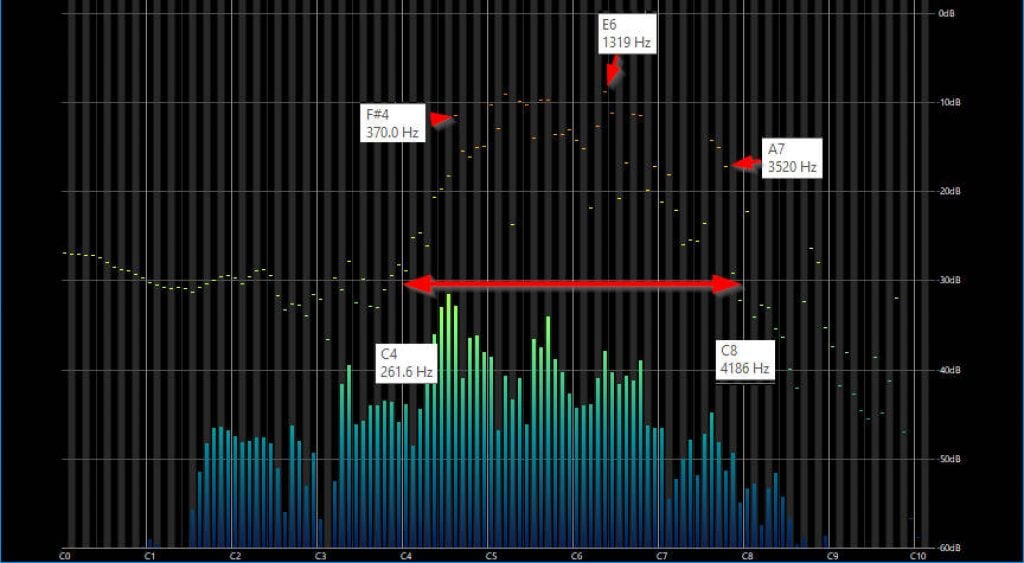
The dots in this graph represent peaks occurring during 16 seconds of multiple dogs (of various breeds) barking.
This is how I blocked this barking noise concert
Luckily, even if it is your next-door neighbor’s dog that is doing the barking, there will normally be a distance between you and the dog(s) and walls/windows to reduce the noise to perhaps 45-50 dB.
But, against the quiet of the night these barks stand out.
In a nutshell, this is what I have found to be effective:
I tried one of my favorite pairs of foam earplugs, and they did significantly reduce the barking noise, but with the dogs barking at 45 to 50 dB, I was still able to hear the peaks, albeit quieter.
So what’s next?
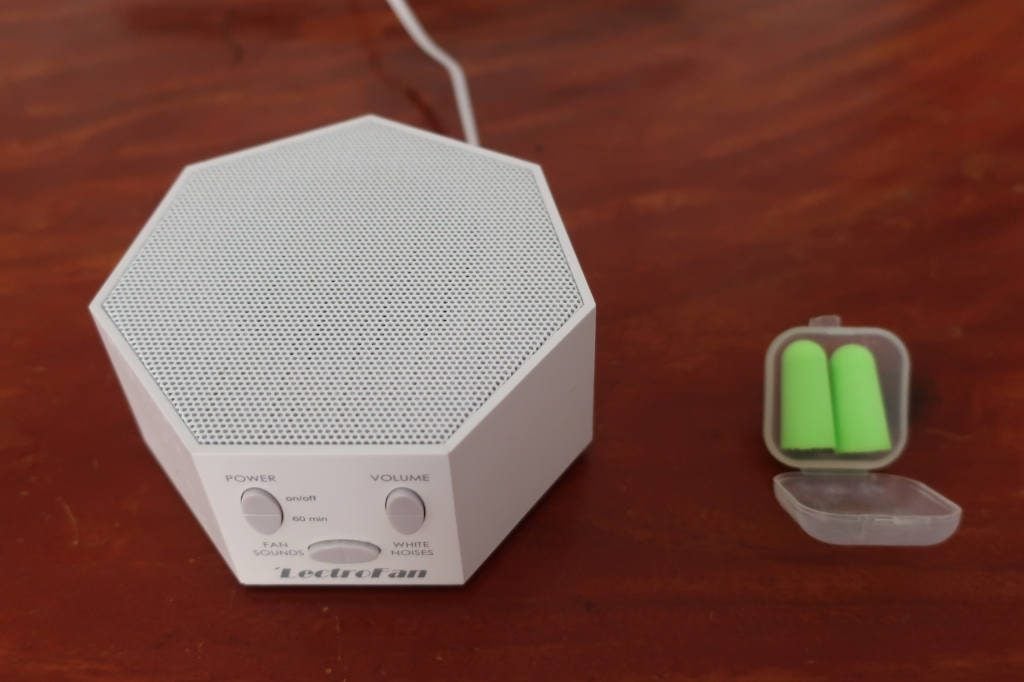
White noise machines that have an adjustable pitch and can be played loud tend to work well for masking mid-frequency noises (e.g., barking) you can hear even with fitted earplugs.
In my experiment, I used the Lectrofan (my go-to white noise machine), set it to white noise #6 (they call that noise pitch “cream”), and increased the volume until the barking was gone.
Success!
Because the white noise has to be played quite loud to render the barks unnoticeable, I recommend you keep wearing foam earplugs (I used Moldex Purafit) to reduce the overall volume to a comfortable level.
Note: The Lectrofan allows you to choose between 10 different white noise pitches. The lower-pitched noises (1-5) also sound good but have less energy in the mid-frequencies important for blocking barking noise, so I would have had to set the machine even louder.
How loud to set the white noise machine?
If you get woken up by barking dogs, you could use them as a reference and set the machine volume so that the barking disappears, or at least doesn’t bother you anymore.
If the resulting overall noise level is then too loud (for me it often would be), add your foam earplugs.
I suggest you try the following approach first:
My preferred method is to opt for partial rather than complete masking:
Because I often sleep with foam earplugs anyway, I first put in my earplugs and then set the white noise volume to a comfortable but clearly noticeable level. (To people not wearing earplugs, this would appear quite loud.)
My objective is not necessarily to completely mask all noises, but to reduce the overall difference between background noise and suddenly occurring noise events.
This approach has worked well for me for barking and many other everyday noises, including traffic noise.
Experiments where white noise was deployed to mask hospital ICU noise back this up: reducing the difference between background noise and sudden noise events to below 15 dB significantly reduced the number of arousals.
What if you don’t want to use earplugs?
If you don’t want to use foam earplugs at all, start with a moderate white noise level—rather than trying to cover all barking possibly occurring during the night.
Provided the barking noise is moderate, the white noise volume may be enough so that the barks don’t arouse you anymore yet still be comfortable.
If your initial volume doesn’t work and you get woken up, you’ve got your barking reference: raise the volume (and perhaps add wax earplugs if you don’t want foam in your ear).
Use headband sleep headphones if your significant other doesn’t agree with the white noise
If you cannot or don’t want to play a white noise machine with an external speaker (e.g., your roommate is much less sensitive to barking but hates the white noise), use headband sleep headphones.
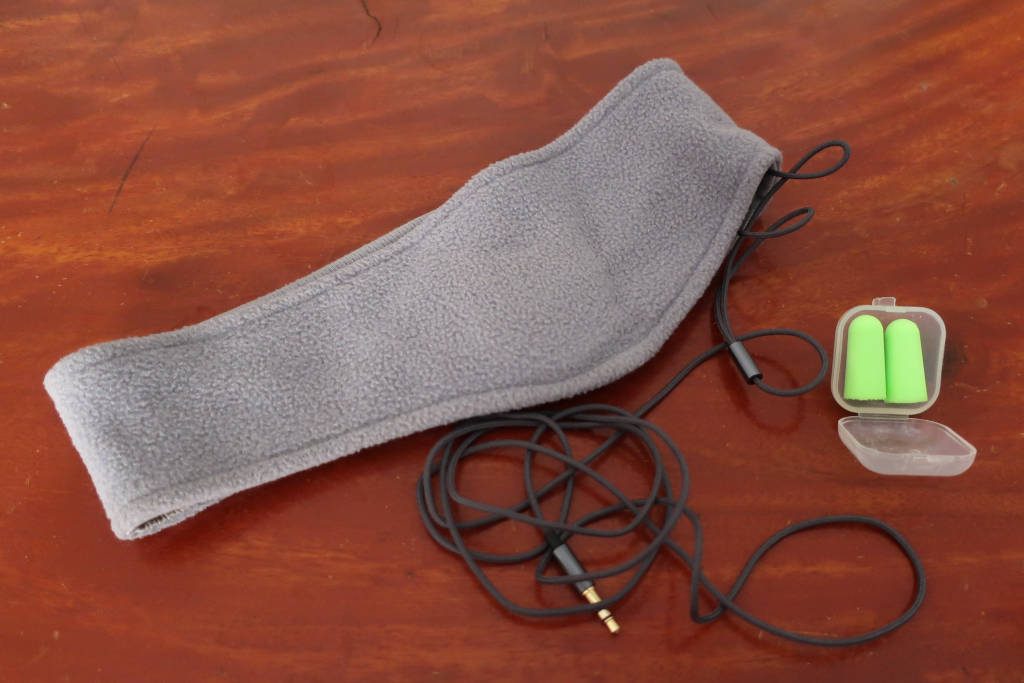
They work just as well:
Play your white noise through these headphones (I use CozyPhones and SleepPhones) and wear earplugs underneath.
As I mentioned earlier, white noise often has to be played fairly loud to mask dog barking, but I don’t want to listen to any noise at a high volume if I can help it.
I want it to sound like a faint waterfall, gentle fan, or modern air conditioner.
As mentioned earlier, I first reduce whatever may be reaching my ear drums using my favorite foam earplugs.
Then I mask the barking noise with sufficiently loud white noise played through the headphones.
As source for your white noise, I recommend myNoise, available as myNoise for iPhones/Ipads and myNoise for Android phones.
The app has a built-in equalizer which is great for optimizing the pitch.
Against dog barks, the following equalizer settings worked well for me when playing white noise through CozyPhones and wearing earplugs underneath:
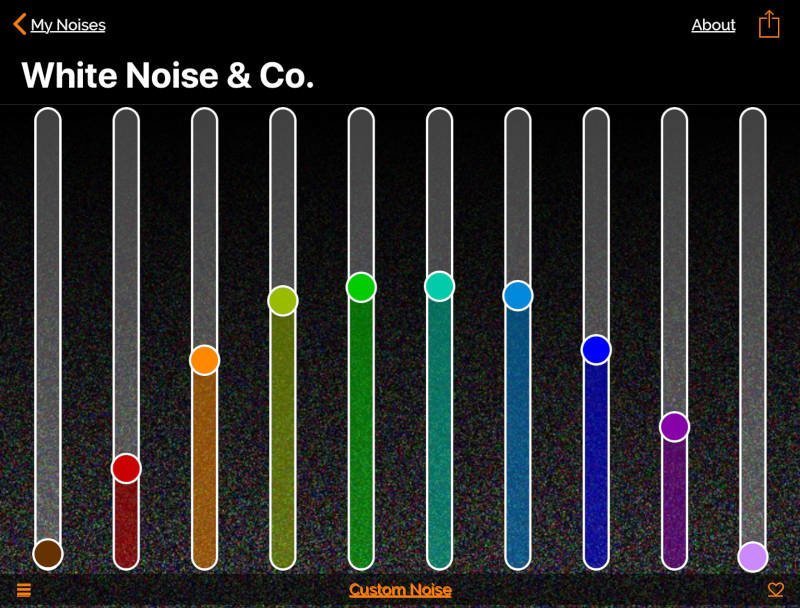
As with the white noise machine, I first put in the earplugs and then raised the white noise volume to a level that was still comfortable.
What do I prefer, headband headphones or white noise machine?
Personally, at night, I prefer the white noise machine + earplug combination, provided I am not bothering anyone.
I want to have as little around my head as possible during sleep. I find this combination hassle-free, effective and comfortable.
But I don’t hesitate to use headband headphones on top of earplugs either. They can be even more effective for playing masking sounds because they are closer to your ear.
But what if you get annoyed by barking noise during the day and don’t want to use earplugs?
Will noise cancelling headphones block out dog barking?
I have tried the Sony WH-1000XM3—currently the most effective noise cancelling headphones I am aware of—with various dog breeds.
Against the lower-pitched barks coming from Rottweilers and German Shepherds, these headphones are surprisingly effective. They remove the lower registers of barking noise well, making these dogs sound much smaller and less frightening—as if they were coming from a small TV with no bass.
The higher pitched parts are also quieter, but if the dog is close, it is still going to be loud.
Against mid-pitched dogs (e.g., the dog in the sound sample) and high-pitched dogs (e.g., Chihuahuas) noise cancelling headphones are less effective. It is mainly the ear cups (rather than active noise cancellation) that reduce the barks of mid-and-high-pitched breeds.
All in all, these noise cancelling headphones make barking more bearable, so they do help, but they won’t cancel loud barking noise.
For comparison, I have also tried a few different hearing protection earmuffs.
Overall, the NRR-30 Peltor Optime 105 earmuffs (review) reduce dog barking better than current noise cancelling headphones. They are more effective in the mid-frequencies and it shows.
I have also tried the NRR-24 Worktunes Connect Bluetooth earmuffs (review) and while they clearly didn’t reduce the lower-pitched parts well as well as the Sony headphones, overall they were as effective.
The Sony headphones are more comfortable, but if you don’t want to play sound to mask barking noise, passive earmuffs with an NRR of at least 24 do do the job as well—unless it’s a Rottweiler’s barks you are trying to block. NRR-30 earmuffs outperform, but they are a bulkier.
Note: Neither earplugs nor earmuffs nor noise cancelling headphones can completely block loud barking. They can take the sting out of it, but don’t expect the barking to be gone.
If you want to improve on this, you need to again add white noise (as described above):
Together with white noise, with both the Sony headphones and the Worktunes Connect earmuffs was I able to mask most of the mid-and-higher-pitched barking noise.
In fact, I found it somewhat easier to mask barking with the economical Worktunes than with the WH-1000XM3.
The Sony headphones are more comfortable than earmuffs though, and music sounds a lot better with them.
Conclusion
Just to be clear:
At night, I definitely prefer earplugs plus white noise machine (and alternatively earplugs + headband sleep phones) over headphones and earmuffs, in particular if the dog is not in the same room.
This combination is effective and a lot more comfy for sleep than over-the-ear headphones.
So here you have it.
Shall we move on to brown bears’ roaring or do you have other ideas?
Please let me know in the comments.
Notes:
- Image credits: Doodle barking, by dahancoo.


![Moldex Pura-Fit vs SparkPlugs [Noise Reduction and Comfort Test] Moldex Pura-Fit vs SparkPlugs [Noise Reduction and Comfort Test]](https://noisyworld.org/wp-content/uploads/2021/06/moldex-pura-fit-vs-sparkplugs-test-200x130.jpg)
![Flents Quiet Time vs Quiet Contour vs Quiet Please [tested] Flents Quiet Time vs Quiet Contour vs Quiet Please [tested]](https://noisyworld.org/wp-content/uploads/2021/06/flents-foam-earplugs-comparative-review-200x130.jpg)
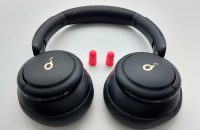


Thank you very much! It’s a very very usable article, one of the best about this problem!
Thank you.
Hello Joze,
Many thanks for stopping by and your very encouraging feedback.
All the best.
Thank you for this excellent info. I have always had a problem with barking dogs above all other source of noise. I’m incredibly sensitive to it. A neighbour recently got a very annoying Jack Russell that barks for a hobby. It wakes me from my sleep and I find it difficult to resettle. White noise probably takes a little getting used to, especially given that up to recently I’ve slept in a silent environment.
Hello Anthony,
yes, getting used to white noise also took me a bit initially.
As mentioned in the post, wearing earplugs helps me to keep the white noise reaching my ears at a comfy level, and I can mask a lot louder barking. This is one of my favorite setups.
All the best.
Hi Helmut,
First and foremost, bless you for writing on this.
My only question to you is you mentioned when utilizing the ear plugs + white noise combination you “set the white noise volume to a comfortable but clearly noticeable level. (To people not wearing earplugs, this would appear quite loud.” Would you consider this to be so loud a neighbor downstairs could hear it? Someone in the next room might be disturbed? How noticeable is this would you say?
I’m just trying to gauge how loud this could potentially be prior to purchasing the white noise machine (as my roommate sleeps in the neighboring room) and since I live in an apartment with neighbors downstairs.
Thanks again for the article 😀
Hi Ahmed,
Thank you for your feedback. That’s a good question.
I use this combination earplugs + white noise machine quite often, and I also have downstairs neighbors.
I doubt they hear anything when I play the machine at my usual volume; they certainly have never mentioned anything.
With “it would appear loud,” I am referring to a person sleeping in the same room.
Following your question, I measured this morning what “clearly noticeable” means to me:
We are talking 50-55 dBA at about 3 feet (1m) away.
Now as to your roommate in the next room: whether they hear anything depends on the sound isolation between your two rooms and how quiet their room is in general.
If the walls are very thin and/or you have sound leaking through the room door, they could hear a slight constant sound curtain (like coming from an HVAC system).
Usually though, it is startling noises and changes in noise level that wake people up and fragment their sleep.
Caveat: If you need to block very loud barking noise, you might have to crank up the white noise machine much louder than what I usually do, say to 70 dB.
But then your roommate might take issue.
Alternatively, you could use earplugs+sleep headphones instead.
All the best.
Thank you for this article. I play white noise every night from Bluetooth speakers. Sometimes, I have to set it very loud PLUS wear ear plugs, but even with this setup, I can still hear the very loud barking of my family’s Belgian Malinois downstairs. I was wondering if the Lectrofan gets very loud. I might consider getting one.
Hi Aviva,
that is a beautiful breed.
At the white noise setting #6 mentioned in this article, the Lectrofan goes loud (about 80 decibels at a distance of 3ft.). Personally I wouldn’t want to play it at max. volume.
Important: To work well, your white noise needs to be loud enough and you need to adjust the pitch to cover the dominant frequencies in your dog’s barking.
Why is your dog is barking? Is it perhaps only doing its job and being a good watch dog?
Here is another idea: some people play white noise (at a moderate volume) to their dog to keep it from hearing and reacting to every little noise.
All the best.
My dogs bark during the day while my wife and I are at work, bothering the neighbors. Will this system counter their barking enough to make it un-noticeable to the neighbors. Good chance they will not be happy if I offer them ear plugs.
Tim
Hello Tim,
this post is geared towards people who want to shield themselves from barking coming from outside.
I assume your dogs are inside the house. I would not try to play white noise inside the house to drown out their barking. Even if possible, that volume would most certainly not be good for your dogs.
That being said, some people play white noise a moderate level (!) to their dog to calm it and make it less sensitive to exterior sounds.
Thank you for your article, I purchased the Lectrofan and I’ve only used it a couple of times, even with earplugs it can be a bit loud, do they take getting used to? My problem is a barking dog outside my window, I am on the third floor but my bedroom window faces the neighbours back yard. I also wear foam earplugs as you suggested, but I’m not sure if I will be able to sleep to the sounds of the Lectrofan. Do you have any other suggestions? I’ve heard that noise cancelling earbuds can affect hearing in the long term, any ideas are much appreciated.
Thanks again.
Regards: Grace.
Hello Grace,
I often sleep with the Lectrofan, so I have definitely gotten used to it.
If even with earplugs, the Lectrofan is too loud at the volume you need it to mask the barks, I would try to optimize the earplug fit first and/or try different foam earplugs.
The difference between well-fitting and not so well-fitting plugs is huge.
Consider this: If you are getting 20 decibels noise reduction, you are getting about a 75% loudness reduction, while with 30 decibels, you are getting nearly 90% loudness reduction. In many cases, getting an extra 10 decibels from your earplugs is very doable. That would make the Lectrofan appear to play a lot quieter.
Noise cancelling earbuds would not be my first choice against barking. Most of them are quite a bit worse in the mid frequencies (in which many dogs’ peaks lie) than earplugs, in which case you would have to play your white noise even louder. Also, you need a pair that fits well with an all-night battery.
If you are a back-sleeper, over-ear noise cancelling headphones are quite effective (again you have to play a white noise app), in particular against lower pitched dogs, but they are expensive.
A more economical option for a back sleeper could be earmuffs with built-in speakers (plus white noise app), such as Worktunes Connect. They are quite effective and they don’t use active noise cancellation, but the headband (clamping) force is a lot higher than that of normal headphones.
I would prefer earplugs against the barks, if at all possible.
All the best.